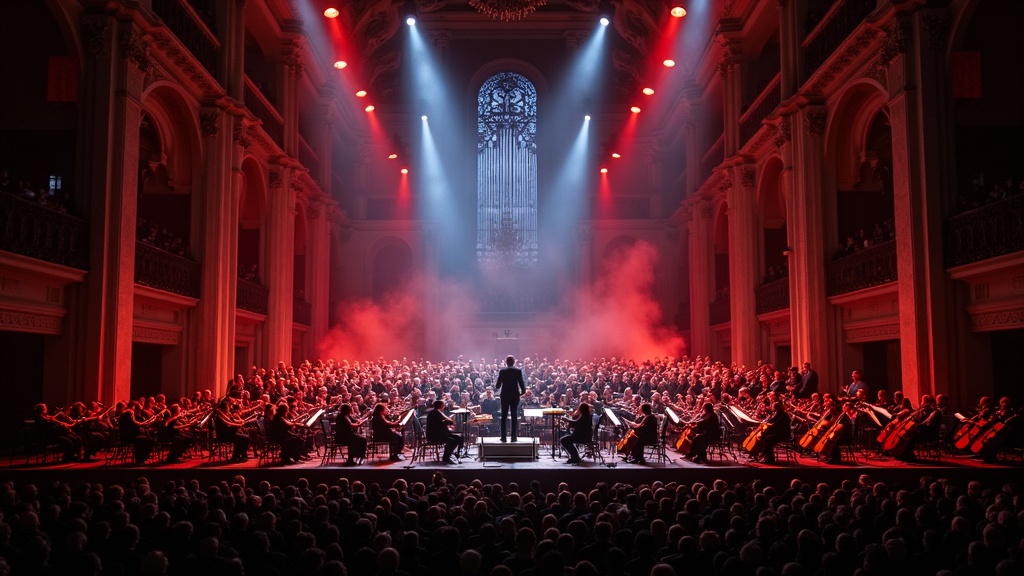Symphonic metal is a genre that packs a massive punch, pulling together the strength of heavy metal with the dramatic atmosphere of classical music. You’ll hear thundering guitars and pounding drums. On top of all that, you get sweeping orchestral sounds and epic choirs that hit you right in the feels. The use of choirs and classical instruments isn’t just a background detail. It’s what gives the genre its cinematic, larger-than-life vibe. You don’t need to be a classical music buff to enjoy this; it’s all about the energy and emotion the music delivers. Here’s a closer look at how choirs and classical instruments shape symphonic metal into something that feels truly epic.

The Fusion of Metal and Classical Elements
Symphonic metal often feels like a movie soundtrack colliding with a rock concert. Classic bands like Nightwish, Epica, and Within Temptation have really leaned into this, using full orchestras and choral arrangements alongside standard rock band instruments. The magic comes from how these layers add depth, emotion, and sometimes a touch of drama you just can’t get with guitars and drums alone.
This blend didn’t just happen overnight. Metal bands in the ‘80s started sprinkling in keyboards and strings for a richer sound. By the late ‘90s and early 2000s, bands began hiring choirs and working with real orchestras. The result is metal that sounds way bigger, almost like a live fantasy or action movie soundtrack. This combination lets bands tap into feelings ranging from the majestic and powerful to the delicate and haunting.
How Choirs Step Up Symphonic Metal
There’s something about the human voice, especially when you layer dozens of voices in a choir, that adds a whole new dimension to metal. Choirs help create a sense of grandeur and intensity. Sometimes they echo a melody, highlight a dramatic moment, or stand on their own for an intro or interlude. The choir’s role is flexible; it can be angelic or monstrous, gentle or ferocious, depending on the mood of the song.
Choirs often take center stage during the biggest choruses or the most emotional climaxes. Think of them as musical fireworks, triggering at just the right moment to turn a powerful song into something truly unforgettable. Tracks like Nightwish’s “Ghost Love Score” and Epica’s “Consign to Oblivion” show how massive a metal song can sound with a full choir soaring behind the band.
Types of Choirs You’ll Hear
- Mixed choirs: Blending soprano, alto, tenor, and bass, these choirs cover the full vocal range and can switch rapidly from delicate harmonies to booming, operatic walls of sound.
- Male or female choirs: Sometimes a band will use all-male or all-female choirs to get a certain tone, either deeper and darker or brighter and lighter, depending on the vibe.
- Children’s choirs: Occasionally, you’ll hear children’s voices for a haunting or otherworldly touch, such as in Xandria’s “Nightfall.”
Classical Instruments: The Soundtrack of Fantasy
Classical instruments are, in my opinion, the secret sauce of symphonic metal. Strings (violin, cello, and double bass), brass (trumpet, trombone, French horn), woodwinds (flute, clarinet, oboe), and piano all help build that cinematic atmosphere. Sometimes, you’ll hear harpsichord, pipe organ, or unusual folk instruments like hurdy-gurdy and bagpipes for extra color.
Each instrument brings something unique; violins and cellos can soar above the guitars with sweeping lines or churning rhythms. Brass and timpani step things up with martial energy, giving songs a “call to battle” feel. Meanwhile, woodwinds or piano can provide soft, introspective moments that stand out from the surrounding intensity.
Commonly Used Classical Instruments
- Strings: Violins, violas, cellos, and double bass make up the backbone of most orchestral sections. They handle both the lush melodies and the aggressive, driving rhythms.
- Brass: Trumpets, French horns, trombones, and tubas create bold brassy harmonies or support the rhythm with stabs and blasts.
- Percussion: Timpani, cymbals, and orchestral snare amp up the drama. Think sudden pauses, crashes, or rolling drums like you’d hear in a movie trailer.
- Woodwinds: Flute, clarinet, and oboe bring a touch of delicacy or mystery, especially in slower passages.
- Others: Harp, piano, and even ancient or folk instruments show up for variety, keeping the sound fresh and surprising.
How Bands Blend Metal and Orchestral Arrangements
Mixing metal with orchestral music takes careful planning for balance and impact. Most symphonic metal groups use three main tools to get the job done:
- Digital keyboards and synths: When hauling an actual orchestra on tour isn’t practical, keyboards step in by simulating strings, brass, and choirs. A skilled keyboardist can put these elements to work live on stage.
- Studio recordings with real orchestras: Bands like Epica, Within Temptation, and Nightwish sometimes partner with big orchestras or professional studio choirs for albums. The resulting sound is lush and authentic.
- Hybrid approaches: Some tracks blend sampled sounds with a few live guest musicians, such as a real violinist or soprano vocalist, blending authentic textures with convenience.
Arranging for Impact
Arranging isn’t about dumping everything in at once. Great bands know how to pick moments for choirs or strings to shine. Often, a verse may be stripped down with just vocals and piano, only to let the full orchestra roar in for the chorus. These pushes and pulls in dynamics make the music more interesting and magnify the heavy parts when they arrive.
Challenges and Solutions When Mixing Elements
Mixing metal and orchestral sounds isn’t always a breeze. Balancing frequencies so guitars and drums don’t drown out the strings, or vice versa, can be tricky. Too much layering can muddy things up. Producers spend hours fine-tuning the mix so every part is clear and powerful.
In live shows, bands get creative. Backing tracks are common, especially for big choir parts or complex string arrangements. On special occasions, bigger shows bring in guest musicians or even local choirs and small ensembles for extra impact. It takes effort, but the end result can be breathtaking when all the elements come together.
What Makes Choirs and Orchestras So Popular in This Genre?
The popularity of classical sounds in symphonic metal probably comes from the emotional punch they deliver. It’s not just about being loud; it’s about building a story or painting a picture in music. Choirs boost the human element, while strings and brass add color and mood in ways electric guitars alone just can’t achieve.
For fans of storytelling—whether in fantasy, myth, or history—these sounds help turn a regular metal song into something magical or inspiring. I’ve also seen fans coming from both worlds: metalheads stumbling upon a love for classical music, and classical listeners discovering a new home amid distortion and double kicks.
Frequently Asked Questions
Here are a few questions I often get about choirs and classical instruments in symphonic metal:
Question: Are most orchestra and choir sounds recorded live or are they digital?
Answer: It’s a mix. Some bands head to the studio with real musicians, but practical limits mean digital keyboards and sample libraries are used a lot, especially for massive choirs or when touring.
Question: Can you play symphonic metal without any classical instruments?
Answer: You can, and some bands stick to synths and guitar-heavy sounds, but those sweeping, epic moments are much harder to pull off without orchestral layers.
Question: Are there bands that tour with a real choir or orchestra?
Answer: It’s pretty rare due to costs and logistics, but special events do happen. Nightwish, for instance, has performed shows with a full orchestra and choir, and some live albums feature these rare collaborations.
Key Takeaways for Fans and Musicians
Choirs and classical instruments give symphonic metal its unique identity. They offer drama, emotion, and that big, epic sound fans can’t get enough of. For musicians, learning to arrange and blend these elements can open tons of creative doors. For fans, getting into this genre is a cool way to stumble upon new classical sounds and see how they mix with the energy of metal.
Whether you’re blasting a symphonic metal album through headphones or are lucky enough to catch a show, it’s nearly impossible to ignore the power and emotion pouring out when heavy metal and classical worlds meet. The genre keeps growing, with more bands and fans each year finding new ways to make metal feel epic, magical, and unforgettable. If you haven’t jumped in yet, there’s no better time than now to check out what symphonic metal has to offer.
